Today we welcome new writer Matt Carter to TFT. He looks at the career of one of England’s chief tormentors this morning …
There were minimal reasons to smile for India during their first test defeat at the hands of England a few weeks ago. However one rare moment of joy was provided by Ishant Sharma claiming his 300th Test wicket. Ishant’s journey to that tally has been a turbulent one. Debuting in 2007 there was ample talk of him being the superstar fast bowler India had long craved, yet by 2013 his star had faded considerably with Ishant’s bowling average sitting at an uninspiring 39 from 53 Tests.
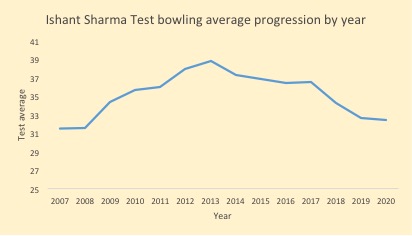
Since 2013 though Ishant’s fortunes have been on the turn. Those improvements were originally gradual, however from 2018 onwards his rise has been emphatic, with Ishant claiming 74 wickets in his last 19 Tests at an average of just 19. That average is second to only Jason Holder amongst seam bowlers to have taken 50 wickets since 2018, whilst Ishant also has the lowest strike rate of any seam bowler during that period. That’s not to say Ishant has been the standout bowler over the past three and a bit years, after all he only ranks 11th for actual wickets, but it’s difficult to deny he is amongst the world’s best seamers – something which would have seemed inconceivable half a decade ago.
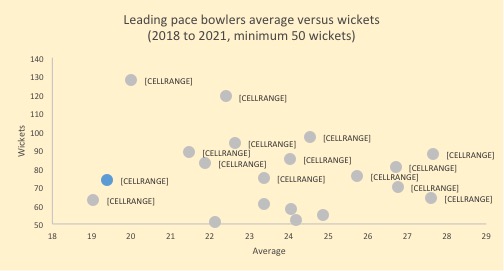
You might wonder if Ishant’s average between 2018 and 2021 has been enhanced by relatively weak opposition, yet whilst that argument might carry some weight in the case of Holder there is simply no mileage in it when comes to Ishant’s record. Since 2018 Ishant has played series in Australia, England, New Zealand and South Africa achieving an average of 24 or lower in each of those countries, whilst his average in India during that timeframe stands at just 18. In fact over the past three years only once has he averaged over 25 in nine completed series – those are without question elite numbers.
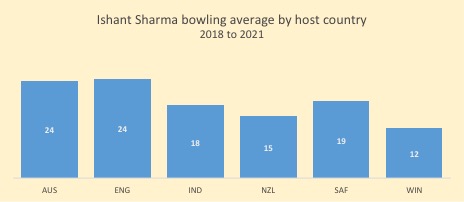
That Ishant has been able to perform with such consistency across a wide variety of conditions is testament to him as a bowler and highlights how his game has transitioned drastically from a mere a raw speed merchant to a somewhat more rounded bowler. The speed might have dropped with time but the current version of Ishant the bowler suggests that was a more than worthy trade.
Ishant’s rise has of course coincided with the emergence of India possessing unquestionably their strongest ever pace and attack, with Jasprit Bumrah and Mohammed Shami averaging 22 and 24 respectively since 2018. Undoubtedly that has assisted Ishant’s ascent, nevertheless it should not negate it. After all the achievements of Pat Cummins are rightly not downplayed by him being part of an attack containing both Josh Hazlewood and Mitchell Starc, similarly James Anderson and Stuart Broad likely benefit from the presence of each.
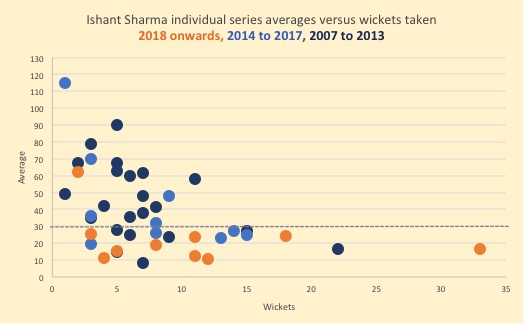
In many ways Ishant’s career to date can be broken down into three portions. It’s easy to forget Ishant actually debuted as a fresh faced teenager and was therefore effectively learning on the job. Not easy for any fast bowler, let alone one playing a significant chunk of his matches on sub continental pitches. It is perhaps therefore of little surprise that of the 20 series in which Ishant has averaged over 35 with the ball 75% arrived prior to 2014. From 2014 onwards Ishant averages 26 which ranks him 11th amongst seamers to have taken 50 or more wickets during that timeframe and as we’ve already discussed that record has improved further throughout the current segment of his career.
His improvements are perhaps best illustrated by his fortunes when travelling to both Australia and England, locations often considered pivotal in the judgement of Indian seamers. His initial experiences in Australia were particularly chastening with 10 Tests across four tours producing just 20 wickets at an average of 62. Yet it is testament to Ishant’s perseverance that 11 wickets at 24 were a key factor in India achieving their first victory in the country back in 2018/19. Similarly in England he primarily struggled averaging a lofty 58 on his first tour before returning to claim 32 wickets at 25 during his subsequent two tours, including a historic match winning seven for 74 at Lords in 2014.
Two matches shy of his 100th Test Ishant now occupies third position when it comes wickets by Indian seamers with Zaheer Khan just a mere 11 wickets away in second spot. Ishant and Zaheer’s records are strikingly similar with Ishant boasting a slightly lower average but Zaheer the narrowly better strike rate. Zaheer arguably was the bowler to transform the perception of Indian fast bowling in the 21st century yet it is difficult to see Ishant not significantly eclipsing his record over the coming years, whilst it shouldn’t be considered inconceivable that Ishant won’t also pass the great Kapil Dev as India’s leading seamer when comes to overall Test wickets. Should he do that he would also climb to the summit of wickets taken by all sub continental pace bowlers.
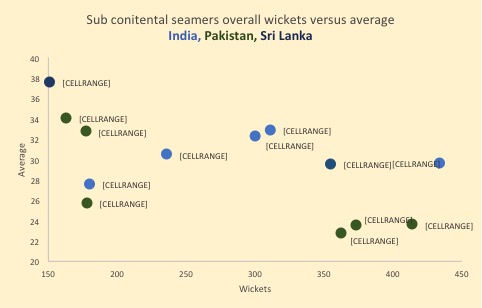
That talk is of course speculation but there is little indication at this stage of Ishant’s fortunes regressing – he bowled superbly throughout the first Test against England despite both the challenging conditions and his lengthy injury layoff. Further to that the accomplishments of both Jimmy Anderson and Stuart Broad are rewriting what fast bowlers can achieve into their thirties. Whether Ishant is able to ultimately topple Kapil Dev or not his transformation into one of the world’s standout seamers should be considered a remarkable achievement.
Matt Carter




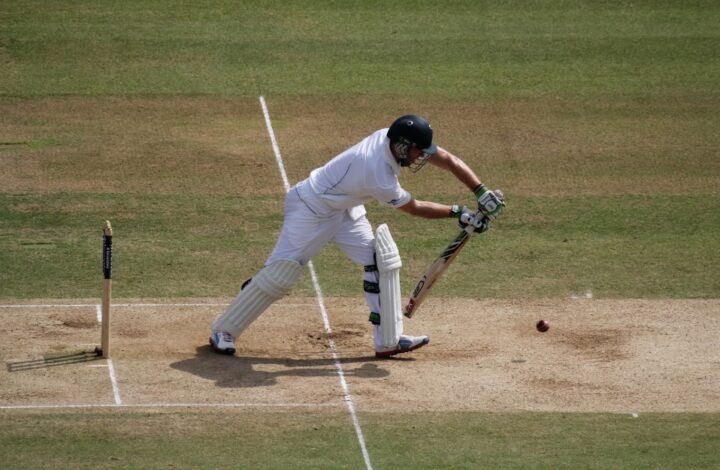



Good to see a promising youngster come through to fulfill potential. Has always been a class act and class will usually out given the opportunities. Great to see a sport where players can be successful well into their thirties. Shows what a difficult game cricket is to learn at the top, especially nowadays with all the different formats players must adapt to.
Disappointing to see England drop Lawrence, who has a preference for spin, and continuing with Pope who clearly hasn’t. Must be another of Mr Eds favourites. Clearly the pitch was always going to favour it. Ten overs of seam to over forty of spin is the norm for this part of the world.
If an average of 21, and of 11 in all his innings bar the first is where having a preference for spin gets you, then maybe it’s better to go with players who don’t !
And no, of course it’s not all down to anything as simplistic or conspiratorial as having to be “another of Mr Ed’s favourites”–but I suspect you already know that on some level.
If there was an obvious reason to carry on with Pope I would agree with the decision. Ashwin clearly has his number at the moment and continued failure will not do him any good.
Incidentally I never said it was all down to Mr Ed, but he’s undoubtedly a factor, Buttler and Bairstow ahead of Foakes as keeper is clearly down to him.
Interesting, 9 wickets to Indian spinners today, and most of them didn’t spin, they went straight on. Mind games.
If you don’t know what the ball is going to do that’s worse than excessive turn every ball. Test cricket needs to be played on pitches that at least start with a measure of consistency. When chunks spill out on the 1st morning that’s unacceptable.
If India deliberately underprepared this wicket it doesn’t matter it’s not dangerous, it’s still cheating. If they’re as good a Kholi’s supposed to believe, why do they need to spoil the game as a contest. For me you forget about this game, there’s no lessons to be usefully learned, just use the anger to concentrate on being hard boiled, so we can rub Kholi’s face in it. It might be a blessing in disguise.
Has Ishant got around to supporting the Indian farmers yet? Have any Indian players, present or past?
Several have told the likes of Rihanna and Great Thunberg to butt out which is a sentiment anyone with brain cells should agree with – but it’s not quite the same thing.
Sorry if I’ve completely missed some sarcasm, but….far from being “not quite the same”, aren’t the two things you’re suggesting completely opposite things?